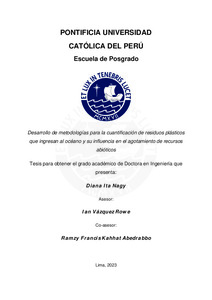Desarrollo de metodologías para la cuantificación de residuos plásticos que ingresan al océano y su influencia en el agotamiento de recursos abióticos
Abstract
En los últimos años, ha habido un aumento significativo en la atención
internacional hacia la acumulación de plásticos en el mar. Aunque se han
realizado esfuerzos para cuantificar fuentes y cantidades exactas de residuos,
así como entender sus impactos, estos intentos siguen siendo limitados. Para
abordar esta problemática, herramientas como el Análisis de Ciclo de Vida
(ACV) deben ser mejoradas e incluir indicadores que estén relacionados con el
potencial daño ambiental de las partículas plásticas en la naturaleza. Además,
se requiere el desarrollo de inventarios de ciclo de vida (ICV) que contemplen
los flujos de plásticos mal gestionados que ingresan al medio ambiente.
En este contexto, esta tesis de doctorado presenta dos objetivos principales.
Por un lado, diseñar una metodología para la cuantificación de flujos plásticos
que estarían entrando al océano desde fuentes terrestres, con el fin de
impulsar la creación de ICVs que los incluyan. Por otro lado, desarrollar una
categoría de impacto de agotamiento de recursos abióticos que considere el
efecto de la disipación de polímeros plásticos en la naturaleza.
La primera parte del estudio permitió identificar diferentes barreras antrópicas
y naturales que afectan el movimiento de los residuos hacia el mar, y diseñar
una ecuación que ilustre la relevancia de los efectos de retención de plásticos.
En la segunda parte, se desarrolló una categoría de impacto ambiental para
cuantificar las consecuencias de estos flujos de materiales mal manejados
dentro del ACV. La categoría de impacto, llamada marine circularity loss,
cuantifica la pérdida de materiales plásticos en el océano que no podrían
reingresar a la cadena de valor. Se espera que estos avances en la
cuantificación de flujos de residuos plásticos y sus impactos en el océano
permitan una toma de decisiones más adecuada frente a esta situación. In recent years, the accumulation of marine plastic has gained international
attention. However, attempts to quantify sources, magnitudes, and related
impacts of marine waste in a more precise way are still limited. It is important
that tools, such as the Life Cycle Assessment (LCA), include linkages to the
potential environmental damage generated by plastic particles in nature.
Likewise, life cycle inventories (LCI) must be developed including flows of
mismanaged plastics that enter nature.
In this context, this doctoral thesis has two main objectives. On the one hand,
to design a methodology for the quantification of plastic flows that may be
entering the ocean from terrestrial sources, in order to promote the creation
of ICVs that include them. On the other hand, the development of an abiotic
resource depletion impact category which considers the effect of the
dissipation of plastic polymers in nature.
The first part of the study made it possible to identify different anthropogenic
and natural barriers that affect the movement of waste towards the sea, and
to design an equation that allowed illustrating the relevance of the effects of
plastic retention. The second part, an environmental impact category to
quantify the consequences of these mismanaged material flows within the LCA
was developed. The impact category, called marine circularity loss, quantifies
the loss of plastic materials in the ocean that are not able to re-enter the
economic value chain. It is expected that these advances in the quantification
of plastic waste flows and their impacts on the ocean will allow for more
appropriate decision-making to address this situation.
Temas
Contaminación marina--Plásticos
Plásticos--Residuos
Agotamiento de recursos
Impacto ambiental--Plásticos
Plásticos--Residuos
Agotamiento de recursos
Impacto ambiental--Plásticos
Para optar el título de
Doctor en Ingeniería
Collections
The following license files are associated with this item:






